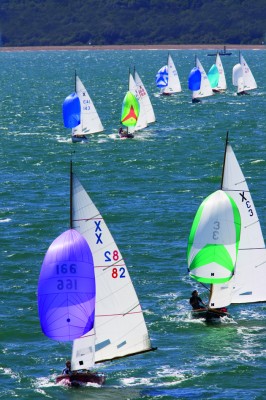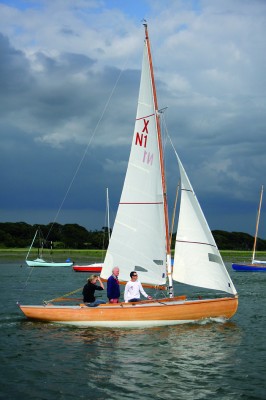An acrimonious incident
There is a popular debate about which builders’ boats are fastest, or in which conditions they have the edge. And however gentlemanly the class may be, there have been those willing to exploit the differences – or even create some new ones.
An ignominious chapter the class has put behind them, but not forgotten, concerns a new batch of boats built in the late Eighties and early Nineties that were found to be too long on the waterline – in one case by as much as 11 inches. People recall the dispute fearful of reviving bitterness.
No one is keen to be quoted directly, but I’m told: “Someone said: ‘Here’s what the measurer measures so let’s get a naval architect to run it through the computer and see what we can find.’ What they did was they dropped the ends of the boat.”
Should these boats have been allowed to race? Was it a simple matter of maximising the waterline allowances under the rule or a shady case of skulduggery? Divided opinions threatened to sour the class. There was “a lot of bitching, so much so that one of the new owners said: ‘If this carries on I’ll sue.’”
To defuse a messy and acrimonious row a compromise was created to allow the series of boats to be rebuilt at the stern and readmitted to the class. Harmony was gradually restored and the measurement process was substantially tightened up.
Whispers of illegality
Whenever boats are being restored or renovated and reappear quicker than expected, you may expect whispers. Peter ‘Basher’ Baines, one of the leading figures in the class, remembers gossip when his boat was remeasured. It was rumoured that, in eight or nine areas, it was ‘nearly illegal’.
As class measurer, John Wilson examines boats that have been renovated, and each boat is weighed and inspected every five years. “People get up to all sorts of tricks,” he admits. “You have to check the floorboards are not overweight or that there isn’t a bucket of water in the boat when it’s being weighed.”
However, he likes to take a practical view: “The important thing is to keep the boats in the water racing.”
Any changes to the class involve great debate. There are ardent views about modernisation, some for and some against. A majority voted to allow epoxy and glue to be used in the planking and the class is contemplating changes to the wooden masts. But any such change depends on there being a 75 per cent majority voting in favour. So change, if it comes, happens slowly and after much reflection.
There are differing views, too, on the surge of new sailors who have come into the class from Etchells and Dragons, attracted by the level of competition and relatively cheap costs of the X, which until recently have changed hands for £4,000 -£12,000.
“Some of the Dragon people have come in and they’ve spent a lot of money. If they find they haven’t done as well as they thought they would, they might not stay in the class,” worries Stuart Jardine.
Others welcome the new blood and think people spending sums they probably won’t recover on older boats is an excellent way of preserving and improving the stock. But the results show that several of these sailors have actually done well. The success of top Dragon and Etchells sailor Neil Payne, who finished 2nd overall in his first Cowes Week in the class, demonstrates that newcomers can crack the Enigma Code of the X.
New X under suspicion
No one has built a new X for some years. The costs are offputting; Lallows in Cowes were approached a couple of years ago and reportedly quoted £40,000-£50,000.
Could modern build methods reduce the costs and pave the way for another century? Ado Jardine, his brother Stuart and a group from Lymington think so and in 2009 built a modern version from strip planking. Their trial horse proved that the cost of a new boat could be pruned to below £30,000. They hoped it would prompt the class to consider revising rules on building methods.
Guess what happened next?
After more debate and firm differences of opinion, the new boat, Xoanon, was not accepted by all divisions and was not allowed to compete at Cowes. “It’s ironic because all the boats are different and some don’t even look the same, but the only X ever built that definitely fits the [measurement] rules hasn’t been allowed in,” says Stuart Jardine. “If no new boats come into the class, it will die. More than half won’t last another century.”
The class captain, William Norris, is cast in the role of peacemaker. He recognises the reasons for looking at cheaper methods of construction if the class wishes to continue to expand. But he also clarifies the counter arguments: “It is a fantastic thing they’ve done, but a strip-planked or cold-moulded boat might be stiffer, at least in the longer term. Clearly we could not have that if there were any chance it might perform better than a traditionally built boat.
“We must also recognise that our class supports traditional boatbuilding skills and that is a good thing.”
The clincher, though, is that a rule change would have to be approved by 75 per cent of members. “That,” predicts Norris, “will be a very difficult thing . . . to achieve and is in the greatest degree remote.”






